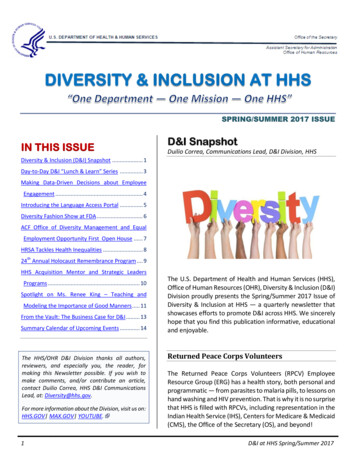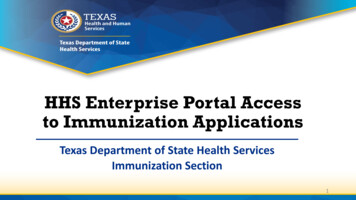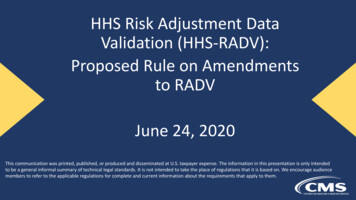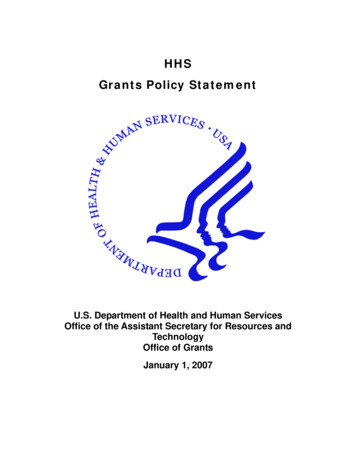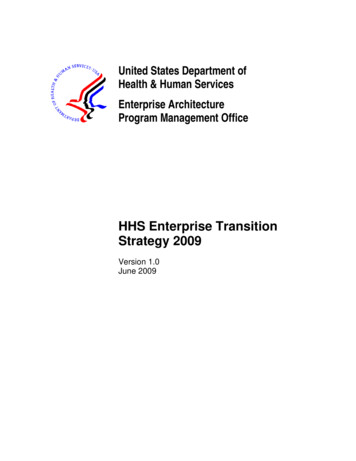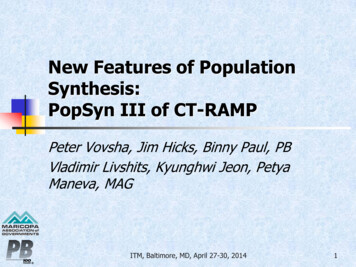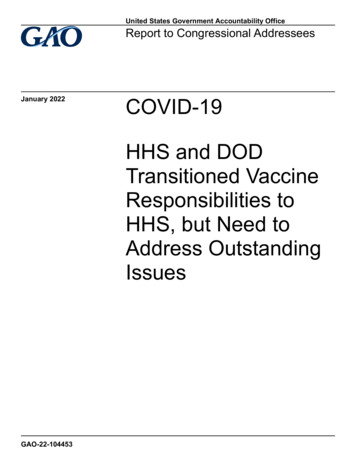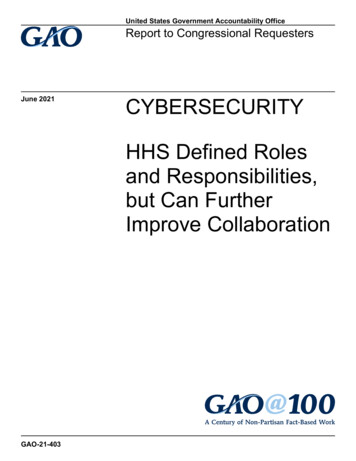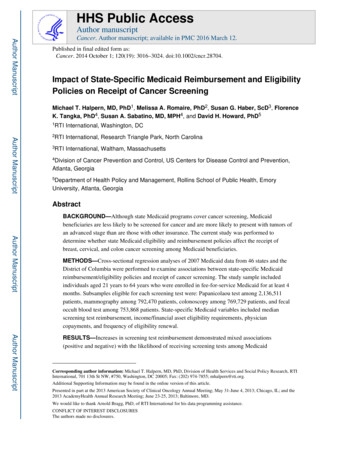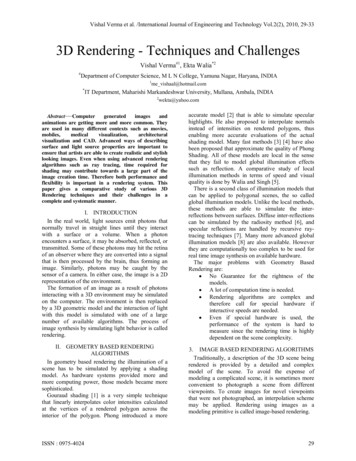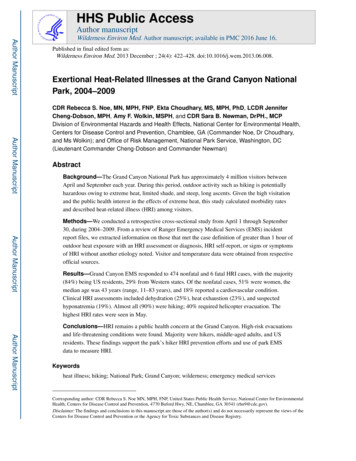
Transcription
HHS Public AccessAuthor manuscriptAuthor ManuscriptWilderness Environ Med. Author manuscript; available in PMC 2016 June 16.Published in final edited form as:Wilderness Environ Med. 2013 December ; 24(4): 422–428. doi:10.1016/j.wem.2013.06.008.Exertional Heat-Related Illnesses at the Grand Canyon NationalPark, 2004–2009Author ManuscriptCDR Rebecca S. Noe, MN, MPH, FNP, Ekta Choudhary, MS, MPH, PhD, LCDR JenniferCheng-Dobson, MPH, Amy F. Wolkin, MSPH, and CDR Sara B. Newman, DrPH., MCPDivision of Environmental Hazards and Health Effects, National Center for Environmental Health,Centers for Disease Control and Prevention, Chamblee, GA (Commander Noe, Dr Choudhary,and Ms Wolkin); and Office of Risk Management, National Park Service, Washington, DC(Lieutenant Commander Cheng-Dobson and Commander Newman)AbstractBackground—The Grand Canyon National Park has approximately 4 million visitors betweenApril and September each year. During this period, outdoor activity such as hiking is potentiallyhazardous owing to extreme heat, limited shade, and steep, long ascents. Given the high visitationand the public health interest in the effects of extreme heat, this study calculated morbidity ratesand described heat-related illness (HRI) among visitors.Author ManuscriptMethods—We conducted a retrospective cross-sectional study from April 1 through September30, during 2004–2009. From a review of Ranger Emergency Medical Services (EMS) incidentreport files, we extracted information on those that met the case definition of greater than 1 hour ofoutdoor heat exposure with an HRI assessment or diagnosis, HRI self-report, or signs or symptomsof HRI without another etiology noted. Visitor and temperature data were obtained from respectiveofficial sources.Results—Grand Canyon EMS responded to 474 nonfatal and 6 fatal HRI cases, with the majority(84%) being US residents, 29% from Western states. Of the nonfatal cases, 51% were women, themedian age was 43 years (range, 11–83 years), and 18% reported a cardiovascular condition.Clinical HRI assessments included dehydration (25%), heat exhaustion (23%), and suspectedhyponatremia (19%). Almost all (90%) were hiking; 40% required helicopter evacuation. Thehighest HRI rates were seen in May.Author ManuscriptConclusions—HRI remains a public health concern at the Grand Canyon. High-risk evacuationsand life-threatening conditions were found. Majority were hikers, middle-aged adults, and USresidents. These findings support the park’s hiker HRI prevention efforts and use of park EMSdata to measure HRI.Keywordsheat illness; hiking; National Park; Grand Canyon; wilderness; emergency medical servicesCorresponding author: CDR Rebecca S. Noe MN, MPH, FNP, United States Public Health Service, National Center for EnvironmentalHealth, Centers for Disease Control and Prevention, 4770 Buford Hwy, NE, Chamblee, GA 30341 (rhn9@cdc.gov).Disclaimer: The findings and conclusions in this manuscript are those of the author(s) and do not necessarily represent the views of theCenters for Disease Control and Prevention or the Agency for Toxic Substances and Disease Registry.
Noe et al.Page 2Author ManuscriptBackgroundAuthor ManuscriptAnnually, 4.4 million people visit the Grand Canyon National Park (canyon), making it oneof the most visited national parks in the United States.1 The majority visit during Aprilthrough September when air temperatures can exceed 100 F (37 C) on the rim and 120 F(44 C) at the bottom of the canyon.1–3 Most visitors view the canyon from the rimoverlooks, although an average of 190,000 visitors camp overnight below the rim andanother estimated 400,000 visitors attempt a day hike into the canyon during this period.2,3The canyon’s topography makes hiking extremely strenuous because of the long (7–14miles) and steep (4,000- to 7,000-foot elevation change) trails that have sparse vegetationavailable for shade, limited potable water, and extreme heat during the summer months.1Consequently, hiking —especially below the rim—can become a potentially serious, evenlife-threatening event, owing to the prolonged exposure to extremely high ambienttemperatures while engaged in strenuous physical activity.1,3,4Author ManuscriptHeat-related illnesses (HRI) range from heat syncope and heat cramps to the most commontype, heat exhaustion.5–7 Heat stroke is the most serious life-threatening condition, andexertional heat stroke (EHS) has been documented among athletes, military recruits, andwilderness enthusiasts engaged in long periods of strenuous physical activity in a hotenvironment.3,5–7 Although similar to classic heat stroke in clinical presentation, EHS oftenresults in rapid onset of severe outcomes such as hyponatremia, acute renal failure,rhabdomyolysis, disseminated intravascular coagulation, and death.5–7 The risk of exertionalHRI may increase as a result of lack of heat and altitude acclimatization, poor conditioning,insufficient shade, advanced age, presence of a chronic disease and certain medications, anddehydration caused by significant sweat loss, inadequate water intake, or both.5,6 AlthoughHRI is recognized as a serious issue at the canyon and prevention programs have been inplace since 1997, the true magnitude, description, and temporal trends of the problem are notwell documented.3,4 This study calculated rates and describes the epidemiology of HRIamong visitors treated by the canyon’s Emergency Medical Services (EMS) during a 6-yearperiod to provide the park with a baseline to examine ongoing prevention programs.MethodsSTUDY DESIGN AND DATA SOURCESAuthor ManuscriptThis was a retrospective, cross-sectional study of HRI cases among park visitors from April1 through September 30 of 2004–2009. A total of 5547 EMS case incident reports wereidentified, and after we excluded those with a clear non-HRI etiology (eg, motor vehiclecrashes, upper respiratory infections), 3360 reports remained. Ranger mortality reports werereviewed for deaths associated with heat exposure. These sources captured only thoseincidents responded to by the National Park Service (NPS) within the park boundaries.CASE-PATIENT IDENTIFICATIONPersons whom EMS treated (or found if deceased) were eligible for inclusion into the studyif they were a visitor during the study period and had a documented outdoor heat exposureof more than 1 hour within the previous 24 hours. To be a case there need to be one of theWilderness Environ Med. Author manuscript; available in PMC 2016 June 16.
Noe et al.Page 3Author Manuscriptfollowing documented indicator(s) of heat illness: 1) paramedic assessment of HRI; 2) selfreport or phrases that indicated “heat” (eg, “overheated, dehydration”) as a contributingfactor; or 3) at least 2 signs and symptoms consistent with HRI not associated with anotheretiology (eg, nausea and vomiting while hiking). This tiered approach was used tosystematically review the EMS case incident reports, which varied in format (eg, SOAP[subjective, objective, assessment, and plan] documentation vs narratives), terminology, andcompleteness. Excluded from the study were canyon residents such as NPS employees,concession employees, volunteers, and family members. These groups were likelyacclimatized to and more cognizant of the heat and the strenuous hiking environment.DATA COLLECTION AND REPORTINGAuthor ManuscriptThe 3360 files were reviewed to determine those that met the case definition (describedabove). Any questions on inclusion or exclusion of cases were discussed among the studyteam. Information on demographics, activity type, clinical assessment, and medical historywas collected on a standardized form. Six age categories ( 5 years, 5–17 years, 18–25 years,26–49 years, 50–65 years, and 65 years and older) were created. Based on the state andcountry of residence, visitors were dichotomized into non-US residents and US residents.US residents were further categorized into the four US Census regions: West, South,Midwest, and Northeast. A categorical variable described the trail location within the canyon(eg, North and South Rim trails) where a case-patient was located by EMS.Author ManuscriptThe medical terminology of the clinical assessment(s) varied, although 8 categoriesemerged: dehydration, heat cramps, heat syncope, heat exhaustion, heat-related illness notspecified, suspected hyponatremia, suspected rhabdomyolysis, and other (eg, suspected renalfailure, heat stroke). The heat-related illness not specified category was established to collatethe nonspecific HRI clinical assessment(s) such as “heat-related illness,” “heat stress,” and“heat sickness.” Because the majority of case-patients had multiple clinical assessmentswithout a primary assessment clearly indicated, frequencies were calculated by tallying thenumber of times each assessment category was recorded in the study population.Author ManuscriptPreexisting chronic medical conditions and medications that have been associated with HRIwere identified. Chronic conditions were organized by the body system(s). In some of therecords, current medication(s) were recorded as drug descriptor (eg, “high BP [bloodpressure] pill”) rather than by a specific drug name or class. To develop a classificationscheme, we used Goodman & Gilman’s pharmacology textbook The Pharmacological Basisof Therapeutics. Using this book’s therapeutic groupings provided a framework to assignsimilar medication descriptions (eg, high BP pill) and medications (eg, atenolol) into theapplicable category based on specific therapeutic use (eg, “regulate cardiovascularfunction”). Six categories were used: 1) cardiovascular drugs and therapies, includingtreatment of hypertension, hypercholesterolemia, and hyperlipidemia; 2) pain medications(eg, opioids, analgesia); 3) anti-inflammatory drugs and other pulmonary pharmacology; 4)hormones (eg, thyroid drugs, diabetic drugs); 5) medication that targeted gastrointestinalfunction; and 6) drug therapy of depression and anxiety disorders.Wilderness Environ Med. Author manuscript; available in PMC 2016 June 16.
Noe et al.Page 4VISITATION AND TEMPERATURE DATAAuthor ManuscriptThe total number of visitors by month and year were downloaded from the NPS visitorstatistics website at http://www.nature.nps.gov/stats/viewReport.cfm. Using the monthlyoverall visitor counts as denominators, rates by month per year were calculated. Historicaldaily maximum temperatures were available from the National Weather Service weatherstations located on the South Rim and at the canyon’s base. Monthly maximum rimtemperatures for each year were calculated by averaging the daily maximum temperaturesfor each month. The rim temperatures were used because not all cases hiked to the bottom,and therefore they were not exposed to the highest temperatures. Temperature data for June2009 were not available.ANALYSISAuthor ManuscriptFor each study year, the rate of HRI per month was calculated per 100,000 visitors using thetotal number of visitors per month as the denominator. Frequencies were calculated usingSAS (version 9.3; SAS Inc, Cary, NC).ResultsNONFATAL CASESAuthor ManuscriptOf 5547 EMS case incident reports, 474 (8.6%) of all nonfatal cases met our case definition.The majority of cases (n 313; 66.0%) were defined based on paramedic assessment of HRIor a narrative indicating heat-relatedness of the signs and symptoms (eg, “succumbed to theheat”). Another 139 (29.0%) met the definition based on signs and symptoms consistentwith HRI plus a supporting narrative indicating prolonged heat exposure while engaged inextreme physical exertion (eg, “strenuous 10-hour hike,” “hiked rim-to-rim today”). Twentythree (5.0%) met the criterion of 2 or more signs and symptoms consistent with HRI (eg,“N/V [nausea and vomiting] after hiking”) not associated with another etiology.Demographic data for HRI cases are presented in Table 1. An equal proportion of males andfemales were found, and the median age was 45 years (range, 11–83 years). Nearly 85.0%were US residents, including 34.9% from the western region states. Residents of Arizona,California, and Colorado made up the highest proportion of HRI cases from this region(58.0%) (Table 1). The most common chronic medical condition was cardiovascular innature, mainly hypertension and hyperlipidemia (17.5%; Table 2). Accordingly, the mostcommon medications were those to regulate cardiovascular function (20.0%). In addition,8.0% of the cases reported taking a prescribed medication(s) to manage an endocrinedisorder (Table 2).Author ManuscriptActivity and location of cases are shown in Table 3. Of all nonfatal HRI cases, most wereengaged in hiking (90.1%) on the South Rim trails (94.0%). More than 69.1% of thenonfatal cases required evacuation assistance; of these, 40.0% were helicoptered out (Table1). The most common EMS clinical HRI assessments of the nonfatal cases includeddehydration (24.5%), heat exhaustion (23.1%), suspected hyponatremia (19.1%), and heatrelated illnesses not specified (16.0%; Table 4).Wilderness Environ Med. Author manuscript; available in PMC 2016 June 16.
Noe et al.Page 5Author ManuscriptThe Figure shows rates of nonfatal HRI and average maximum rim temperature on the SouthRim by month for each study year. Although the monthly visitation remained constant, noconsistent pattern(s) appeared during the years or months in terms of HRI rate except forMay of most years, which had a noticeable increase in rate. The highest HRI rate (5.31 per100,000 visitors) was observed in May 2006 (Figure). The median spring and summertimeseasonal HRI rate was 2.64 per 100, 000 visitors (range, 2.34–2.86 per 100, 000 visitors).FATALITIESSix HRI fatalities were identified, and the majority were male (83.3%) and between the agesof 26 and 49 years (33.3%) and 50 and 65 years (33.3%). All of the fatal cases were USresidents and were hiking the canyon at the time of death (Table 1). No other details wereavailable.Author ManuscriptDiscussionDuring the 6-year study period, nearly 9% of all EMS encounters were identified as HRI,and the majority of the case-patients were US residents hiking the inner canyon trails on theSouth Rim. They tended to be middle aged, at least a quarter of the nonfatal cases hadknown HRI risk factors such as cardiovascular and endocrine conditions, and nearly 40%were on prescription medications to address these disorders.Author ManuscriptAuthor ManuscriptPrevious canyon studies have identified exertional HRI among hikers and inner canyonrangers; however, these studies focused on hyponatremia and heat exhaustion during shorttime periods, whereas our study identified all types of HRI treated over the course of severalyears.3,4 Other park EMS studies have indicated HRI is a common problem, although thisassessment was often aggregated with other conditions and not stratified by demographics oractivity. For example, a study of 8 California National Parks found “dehydration or heatstroke” to be the fifth most-common illness among visitors overall.8 Similarly, at YosemiteNational Park from 1990 to 1999, the most common complaint treated by EMS was for“dehydration, hypovolemia, and hunger”; however, it was unclear whether these were relatedto heat or overexertion, and no demographics or other information were presented.9Interestingly, among our cases, the frequency of HRI was highest among Arizona,California, and Colorado residents, which could be a reflection of a greater frequency ofthese regional visitors; however, one would assume they should be better informed andaware of the extreme heat and topography of the canyon compared with other visitors. MostHRI cases were treated on the most popular and easily accessible below-the-rim trails on theSouth Rim. The majority of evacuations were by helicopter, which may be a sign of theseverity of the patient’s condition or the remote and austere environment. These findingssupport the existing prevention strategies to target hikers on South Rim trails, especiallyduring the summer months when the South Rim usage is the heaviest by tour operators andthe average visitor.1As seen in other heat studies, we noted a rate increase in May; this is often explained as alack of acclimation to heat at the beginning of summer.5,6 Acclimatization improves thebody’s ability to adapt to hot environments through increasing the sweat rate and decreasingelectrolyte loss, resulting in better heat tolerance.7 Improved fitness and acclimatizationWilderness Environ Med. Author manuscript; available in PMC 2016 June 16.
Noe et al.Page 6Author Manuscripttraining is an effective HRI prevention strategy for visitors, and NPS should considerhighlighting these on their hiking webpage.1 The prevalence of cardiovascular and endocrineconditions, as well as corresponding use of medication for these disorders among the HRIcases, are important findings as these are known risk factors for HRI.7 In hot environments,both cardiovascular disease and certain medications (eg, β-adrenergic blocking agents,diuretics) can impact the body’s ability to sufficiently increase cardiac output needed todissipate heat via peripheral vasodilation.7 Visitors with chronic medical conditions mightconsider consulting with their medical provider when planning a canyon hiking trip.LIMITATIONSAuthor ManuscriptAuthor ManuscriptThere are some important limitations of this study; the accuracy of the paramedic clinicalHRI assessments is uncertain without diagnostic confirmation from a medical provider orlaboratory examination. However, previous canyon studies found that 10% of EMSencounters were for HRI.3 Misclassification of heat relatedness might have occurred,although most had narratives documenting prolonged exercise and extreme heat exposure(eg, 10 hours of hiking, 120 F). In addition, our study’s annual number of HRI cases andproportion of these to the total EMS encounters were consistent with previous internal heatsummary audits compiled by the canyon’s EMS. To assist in systematic screening of thefiles, we used a table of HRI conditions with corresponding signs and symptoms publishedby the National Athletic Trainers’ Association, which included exertional hyponatremia.3,6We recorded rhabdomyolysis as we knew that EMS was documenting if they suspected thisoutcome. Additional cases were missed if they directly sought medical care at the park’sclinic; therefore, we likely underestimated the true HRI burden. Several park studies haveused the EMS clinical assessment to determine the incidence of injuries and illnesses despitethe difficulty and overlap in clinical impression inherent in prehospital preliminaryexaminations.10 A study of HRI cases seen in the canyon’s clinic and surrounding areahospitals is warranted. We anticipate that this study will encourage other parks with extremeheat (eg, Death Valley) to examine their EMS data for HRI to better understand the problem,improve medical services including assessment and documentation of HRI, and targetprevention strategies.ConclusionsAuthor ManuscriptHRI among hikers remains a public health concern at the Grand Canyon National Park.High-risk evacuations and life-threatening conditions were identified. Across the UnitedStates, exposure to extreme heat is a growing national concern. And for this reason, NPSunderstands that the HRI burden and identification of those requiring EMS assistance isimportant—both to improve service delivery and to target specific park messagingthroughout the park system.AcknowledgmentsThe authors thank the Grand Canyon EMS leadership: Rangers Ken Phillips, C.J. Malcolm, and Bonnie Taylor forall their assistance on this study. Funding support for this study was provided by the National Center forEnvironmental Health, Division of Environmental Hazards and Health Effects.Wilderness Environ Med. Author manuscript; available in PMC 2016 June 16.
Noe et al.Page 7Author ManuscriptReferencesAuthor Manuscript1. National Park Service. [Accessed November 3, 2012] Grand Canyon National Park—Plan YourVisit. Available at: http://www.nps.gov/grca/planyourvisit/index.htm2. Backlund, EA.; Stewart, W.; Schwartz, Z.; McDonald, C. Backcountry Day Hikers at Grand CanyonNational Park. Champaign, IL: University of Illinois; report submitted to Grand Canyon NationalPark; 2006.3. Backer HD, Shopes E, Collins SL, Barkan H. Exertional heat illness and hyponatremia in hikers.Am J Emerg Med. 1999; 17:532–539. [PubMed: 10530529]4. Krake A, McCullough J, King B. Health hazards to park rangers from excessive heat at GrandCanyon National Park. Appl Occup Environ Hyg. 2003; 18:295–317. [PubMed: 12746072]5. Armstrong LE, Casa DJ, et al. American College of Sports Medicine; American College of SportsMedicine position stand. Exertional heat illness during training and competition. Med Sci SportsExerc. 2007; 39:556–572. [PubMed: 17473783]6. Binkley HM, Beckett J, Casa DJ, Kleiner DM, Plummer PE. National Athletic Trainers’ Associationposition statement: exertional heat illnesses. J Athl Train. 2002; 37:329–343. [PubMed: 12937591]7. O’Brien, KK.; Leon, LR.; Kenefick, RW. Clinical management of heat-related illnesses. In:Auerbach, P., editor. Wilderness Medicine. 6. St Louis, MO: Mosby, Inc; 2012. p. 232-238.8. Montalvo R, Wingard DL, Bracker M, Davidson TM. Morbidity and mortality in the wilderness.West J Med. 1998; 168:248–254. [PubMed: 9584662]9. Hung EK, Townes DA. Search and rescue in Yosemite National Park: a 10-year review. WildernessEnviron Med. 2007; 18:111–116. [PubMed: 17590068]10. Forrester JD, Holstege CP. Injury and illness encountered in Shenandoah National Park. WildernessEnviron Med. 2009; 20:318–326. [PubMed: 20030438]Author ManuscriptAuthor ManuscriptWilderness Environ Med. Author manuscript; available in PMC 2016 June 16.
Noe et al.Page 8Author ManuscriptAuthor ManuscriptAuthor ManuscriptFigure.Rate of nonfatal heat-related illness (bars) and average maximum on-the-rim temperature(dots connected with lines) by month, Grand Canyon National Park, April throughSeptember, 2004–2009.Author ManuscriptWilderness Environ Med. Author manuscript; available in PMC 2016 June 16.
Noe et al.Page 9Table 1Author ManuscriptDemographics and evacuation status of nonfatal heat-related illness cases at the Grand Canyon National Park,April through September, 2004–2009 (n leSexAge category (years) thor Manuscript 65CitizenshipUS residentNon-US residentUS Census icopter18839.66Walk-assisted11123.42Evacuation methodAuthor ManuscriptOther (eg, mule, litter carry)a326.75No evacuation reported (eg, not applicable, missing)7916.66Refused additional treatment (AMA)6413.50Owing to missing values, percentage will not add up to 100%.bFor those who were US residents, by US Census regions: Northeast region (CT, ME, MA, NH, RI, VT, NJ, NY, PA); Midwest region (IL, IN, MI,OH, WI, IA, KS, MN, MO, NE, ND, SD); South region (DE, DC, FL, GA, MD, NC, SC, VA, WV, AL, KY, MS, TN, AR, LA, OK, TX); and Westregion (AZ, CO, ID, MT, NV, NM, UT, WY, AK, CA, HI, OR, WA).Author ManuscriptWilderness Environ Med. Author manuscript; available in PMC 2016 June 16.
Noe et al.Page 10Table 2Author ManuscriptMedical conditions and prescription medications of nonfatal heat-related illness cases, Grand Canyon NationalPark, April through September, 2004–2009 (n 474)Variablen%Cardiovascular (eg, HTN, hyperlipidemia)8317.47Endocrine (eg, diabetes, Respiratory (eg, COPD, asthma)244.84Muscular skeletal (eg, orthopedic conditions)224.63At-risk conditions for HRI (eg, past HRI, mental health conditions, anemia, acute infection)255.26Other (eg, cancer, migraine)275.68Cardiovascular drugs (eg, HTN, hyperlipidemia)9620.21Hormones (eg, estrogen, diabetes medications including insulin, thyroid, oral/inhaled steroids)7716.21Pain medication (eg, analgesia, nonsteroidal, opioids, migraine)306.32Anti-inflammatory (eg, histamine, nonsteroidal pulmonary drugs)255.26Drug therapy for depression and anxiety disorders194.00Gastrointestinal medication (eg, GERD, antiemetic)163.37Other drugs (eg, antibiotics, acne meds, bone density, multi-vitamins)336.95Chronic Medical ConditionsDrug Therapeutics CategoriesAuthor ManuscriptCOPD, chronic obstructive pulmonary disease; GERD, gastroesophageal reflux disease; HRI, heat-related illness; HTN, hypertension.Author ManuscriptAuthor ManuscriptWilderness Environ Med. Author manuscript; available in PMC 2016 June 16.
Author ManuscriptAuthor ManuscriptAuthor Manuscript2 (0.52)13 (3.39)3 (0.78)328 (85.42)346 (90.10)Hiking0 (0.00)0 (0.00)15 (3.91)0 (0.00)15 (3.91)Walking9 (2.34)0 (0.00)0 (0.00)0 (0.00)9 (2.34)0 (0.00)0 (0.00)0 (0.00)10 (2.60)10 (2.60)Mule ridingActivity type, n (%)Rafting on river0 (0.00)0 (0.00)4 (1.04)0 (0.00)4 (1.04)Other (eg, biking)Missing data 126 nonfatal heat-related illness cases with no information on location and activity.RiverInner canyon trailsNorth RimRim trailsInner canyon trailsSouth RimAll locationsLocation11 (2.86)13 (3.39)22 (5.73)338 (88.02)348 (100.00)TotalActivity engaged by nonfatal heat-related illness cases at onset of illness and location of incident, Grand Canyon National Park, April through September,2004–2009 (n 348)Author ManuscriptTable 3Noe et al.Page 11Wilderness Environ Med. Author manuscript; available in PMC 2016 June 16.
Noe et al.Page 12Table 4Author ManuscriptParamedic assessments of visitors with heat-related conditions, Grand Canyon National Park, April throughSeptember, 2004–2009 (n 474)Paramedic assessmentsan%Dehydration11624.47Heat t-related illness (HRI) not specifiedb7415.61Heat cramps122.53Heat er (suspected renal failure, heat stroke)Author ManuscriptaMore than one diagnosis per person.bThe HRI not specified category was established to collate assessments such as “heat sickness,” “HRI,” “heat-illness,” and other nonspecific HRIterms.Author ManuscriptAuthor ManuscriptWilderness Environ Med. Author manuscript; available in PMC 2016 June 16.
Exertional Heat-Related Illnesses at the Grand Canyon National Park, 2004-2009 CDR Rebecca S. Noe, MN, MPH, FNP, Ekta Choudhary, MS, MPH, PhD, LCDR Jennifer Cheng-Dobson, MPH, Amy F. Wolkin, MSPH, and CDR Sara B. Newman, DrPH., MCP Division of Environmental Hazards and Health Effects, National Center for Environmental Health,
